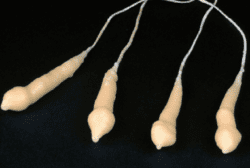Candles, Roman, 500 BCE
Candles were first mentioned in Biblical times, as early as the tenth century BCE. These early candles were made of wicks stuck into containers filled with a flammable material.
The first dipped candles were made by the Romans from rendered animal fat called tallow. Since tallow is cheap and easily available, tallow candles were the most widely used types of candles for centuries.
In the 1500’s, beeswax was introduced as an alternative to tallow. Beeswax candles burn brighter and longer with less smoke, and they smell better than tallow candles. However, beeswax was more difficult to obtain, which meant that beeswax candles were used almost exclusively by the upper classes and the Church in Europe during this time. All candles were made by dipping until the 1400’s, when a French inventor introduced molds for taper candles.
Other materials which have been used for candles more recently include spermaceti, a waxy material obtained from the sperm whale, paraffin, which is made from coal and oil shales, and bayberry wax, which is a residue left from boiling huge quantities of bayberries. Wicking can be made from almost any kind of fiber; one of the most common in early days was loosely spun cotton.
Method of Construction
Constructed by: Natasha Baker ’01, Laura Brandt ’01, and Carole Zakrzewski, ’00
We had to carry out several preliminary steps before we could begin making actual candles. We began by rendering animal fat into tallow. This process was relatively easy because we used lard rather than cut up bits of fat, and most of the impurities were already gone. We boiled the lard with a little water and a few teaspoons of salt to leach out any remaining impurities for about an hour. Then we poured the liquid fat into a bowl and left it to solidify. The second part of our preparation was spinning cotton for our wicks.
The candle making itself took an entire day. We began by melting the tallow in a double boiler arrangement. We tied our spun cotton wicking to short sticks and once the tallow had liquified, we dipped the wicks into the tallow. We realized that we needed a way to cool the candles between dippings, and we got a second container of cool water. We dipped each candle into the tallow, then into the water to cool. It took about two hours of repeated dipping to make the tallow candles. The beeswax candles, on the other hand, took about half an hour using the same method because beeswax has a much higher melting temperature than tallow, and the candles cooled between dips much faster. The leftover wax was poured into containers with wicks suspended in them to make small pillar candles.
Resources
Berthold, Robert Jr. Beeswax Crafting. Connecticut: Wicwas Press, 1993.
Bramson, Ann. Soap: Making It Enjoying It. New York: Workman Publishing Company, 1972.
Roy, L.M.A. The Candle Book. Brattleboro: Stephen Daye Press, 1938.




